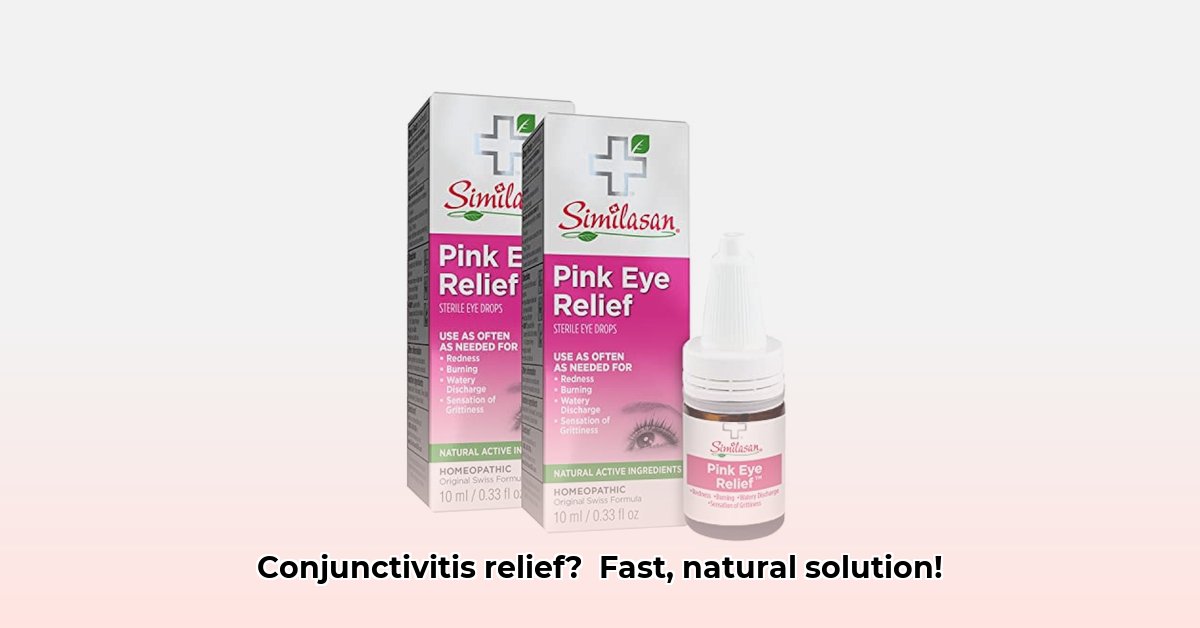Experiencing the discomfort of pink eye (conjunctivitis)? The itchiness, redness, and burning sensations can be incredibly disruptive. This article offers a comprehensive overview of Similasan eye drops, a homeopathic option designed to alleviate conjunctivitis symptoms. We’ll delve into the nature of pink eye, explore its various types, and examine the purported mechanisms of Similasan. Furthermore, we’ll present an objective assessment of the scientific evidence (or lack thereof) supporting its effectiveness. Crucially, we will emphasize the necessity of seeking professional medical advice for accurate diagnosis and treatment, particularly in cases of severe or persistent pink eye. Consider this a balanced perspective on Similasan – exploring its potential benefits, limitations, and suitability for your specific needs.
Understanding Conjunctivitis and Exploring Potential Relief with Similasan Eye Drops
Conjunctivitis, commonly known as pink eye, is a prevalent eye condition affecting millions worldwide each year. It manifests as an inflammation of the conjunctiva, the delicate membrane that covers the white part of your eye and the inner surface of your eyelids. Imagine this membrane as the eye’s protective lining, which becomes irritated and inflamed. Though typically not a serious condition, pink eye can be quite uncomfortable and disruptive to daily life. Conjunctivitis is categorized into several types based on its cause: viral, bacterial, and allergic. Accurate differentiation between these types is crucial for selecting the appropriate treatment strategy, emphasizing the importance of professional diagnosis for effective relief.
Exploring the Formulation and Potential of Similasan Eye Drops for Conjunctivitis
Similasan eye drops are a homeopathic remedy frequently recommended for alleviating pink eye symptoms. Homeopathy operates on the principle of “like cures like,” utilizing highly diluted substances to stimulate the body’s natural healing mechanisms. Similasan’s formulation includes natural ingredients such as Belladonna,Euphrasia officinalis (eyebright), and Hepar sulphuris calcareum (calcium sulfide). These substances have a history of use in traditional medicine for addressing various ailments, potentially offering soothing and therapeutic effects for the eyes. But what does the scientific research reveal about their actual effectiveness in combating pink eye and its associated inflammation?
Examining the Scientific Evidence (or Lack Thereof) for Conjunctivitis Treatment
Here’s a transparent assessment: Current scientific evidence supporting the effectiveness of Similasan eye drops for treating conjunctivitis is limited. Regulatory bodies, like the Food and Drug Administration (FDA) in the United States, do not evaluate the effectiveness of homeopathic products for treating specific medical conditions. Some individuals report experiencing symptom relief with Similasan; however, this improvement may be attributed to the natural course of the condition’s resolution or the placebo effect – feeling better simply because you believe you are receiving treatment. It’s crucial to acknowledge these factors before relying on Similasan for conjunctivitis relief. Further rigorous research is needed to fully elucidate its potential benefits. The scientific community currently holds divided opinions regarding the efficacy of homeopathic treatments. While some studies suggest a possible placebo effect, ongoing investigations aim to determine if subtle biological mechanisms are involved, resulting in uncertainty regarding treatment efficacy.
Determining When Similasan Eye Drops Might Be Suitable for Mild Conjunctivitis
Similasan eye drops may offer temporary relief from mild symptoms associated with viral or allergic conjunctivitis, such as redness, itching, and a burning sensation. Envision it as providing a soothing effect on the discomfort rather than eradicating the underlying cause. Crucially, it is not a substitute for the antibiotic treatments prescribed by a doctor for bacterial conjunctivitis. Bacterial conjunctivitis necessitates targeted intervention; otherwise, the infection can persist or potentially spread. Consulting a healthcare professional is paramount if your symptoms are severe, persistent, or suggestive of a bacterial infection. Self-treating bacterial conjunctivitis can result in complications and prolonged discomfort. Experts consistently emphasize the importance of seeking consultation with a healthcare provider for accurate diagnosis and appropriate management strategies.
Evaluating the Benefits and Drawbacks of Similasan Eye Drops for Conjunctivitis Relief
Conjunctivitis affects an estimated 6 million individuals annually, underscoring the demand for effective treatment solutions. Here’s a balanced comparison of the potential advantages and disadvantages:
| Pros | Cons |
|---|---|
| Generally regarded as safe, with minimal risk of adverse effects. | Limited scientific validation supporting effectiveness against conjunctivitis. |
| Composed of natural ingredients. | May only deliver temporary symptom alleviation, not a comprehensive cure. |
| Easily accessible over-the-counter. | Ineffective for bacterial conjunctivitis; necessitates suitable antibiotic therapy. |
| Potentially appropriate for use in children. | Effectiveness is likely attributable to a placebo response in numerous instances. |
| Can provide relief from mild irritation. | Does not address the fundamental cause of conjunctivitis. |
Practical Guidelines and Key Considerations for Conjunctivitis Management
Conjunctivitis accounts for approximately 1% of all primary care visits, indicating the prevalence and significance of this condition. Here’s what you should consider:
- Seek professional medical evaluation: Consult a healthcare professional or eye specialist promptly if your symptoms are severe, fail to improve within a few days, or worsen. They can accurately diagnose the type of conjunctivitis and recommend the most appropriate course of treatment.
- Accurate Diagnosis is Essential: Determining whether your pink eye is viral, bacterial, or allergic is essential to choose the right treatments. This assessment should be made by a healthcare professional.
- Maintain realistic expectations: Recognize that Similasan eye drops do not provide a guaranteed cure. They might offer some comfort, but they are unlikely to completely resolve the underlying issue, particularly in the case of bacterial infections.
- Adhere to instructions precisely: Carefully read and follow all instructions provided on the Similasan eye drop packaging.
- Explore alternative treatment options: Discuss alternative treatments, such as over-the-counter artificial tears or prescription medications, with your healthcare provider. They can provide guidance on the optimal treatment strategy based on your specific circumstances and the type of conjunctivitis you have.
Remember, this information serves educational purposes and should not substitute professional medical advice. Prioritize your eye health by consulting a healthcare professional for an accurate diagnosis and personalized treatment approach. Seeking professional medical advice is always the safest option, even in the presence of mild symptoms.
Similasan and Conjunctivitis: Dissecting Effectiveness
Key Takeaways:
- Similasan eye drops are a homeopathic remedy and not a substitute for professional medical advice.
- Some individuals find that Similasan helps with mild symptoms, such as itching or dryness, associated with viral or environmental conjunctivitis.
- How effective is Similasan for bacterial conjunctivitis? It’s ineffective. Antibiotics are necessary to combat bacterial conjunctivitis.
- Always seek a doctor’s diagnosis and treatment, especially if your symptoms are severe or do not improve.
- Similasan’s appeal lies in its natural ingredients and its suitability for use in sensitive eyes. However, this does not guarantee its effectiveness.
Unveiling Conjunctivitis and its Various Forms
Conjunctivitis, also known as pink eye, is characterized by inflammation of the conjunctiva (the membrane that lines the eyelids and covers the white part of the eye). It is classified into several forms: viral, bacterial, and allergic. Each type demands specific therapeutic approaches. Viral conjunctivitis often resolves without intervention. Allergic conjunctivitis responds to antihistamines (allergy medications). However, bacterial conjunctivitis necessitates antibiotic treatment, demonstrating the diverse modalities.
Similasan: Examining Its Role as a Homeopathic Treatment for Conjunctivitis
Similasan is classified as a homeopathic product, which employs highly diluted substances to stimulate the body’s inherent healing processes. The manufacturer suggests that its eye drops can alleviate a range of eye irritations, including some types of conjunctivitis. However, it is important to note that homeopathy lacks broad scientific validation. Therefore, it is vital to approach it with informed expectations.
Similasan and Bacterial Conjunctivitis: Addressing the Truth and Scientific Evidence
Let’s address the primary question: how effective is Similasan for bacterial conjunctivitis? The answer is that it is not effective. Bacterial conjunctivitis is caused by bacteria, and these infections necessitate antibiotic intervention for eradication. Similasan does not target the underlying bacterial infection. Using it instead of antibiotics may delay appropriate healing, possibly resulting in complications and prolonged discomfort.
Similasan for Other Conjunctivitis Types and Treatment Options
While not effective against bacterial conjunctivitis, some individuals report symptom relief from Similasan when dealing with milder cases of viral or environmentally induced conjunctivitis. Any experienced relief may originate from the placebo effect or the soothing qualities of the inactive ingredients. A combination of both is also possible! Additional alternative treatments include artificial tears, which may also deliver some symptomatic relief.
When Should You Consult a Doctor for a Conjunctivitis Diagnosis?
Do not depend on homeopathic remedies as the sole treatment modality for any eye condition. If you have conjunctivitis, particularly if it is severe, persistent, or you suspect it is bacterial, consult a doctor. Prompt diagnosis and treatment can prevent complications and ensure the receipt of effective care, potentially preventing progression or transmission of infection.
Deliberating the Pros and Cons of Using Similasan Eye Drops
| Pros | Cons |
|---|---|
| Formulation is natural and preservative-free | Lacks scientific evidence |
- Why an App Appeared on My Phone Unexpectedly - November 22, 2025
- How to Stop Unwanted Apps from Automatically Downloading on Android - November 21, 2025
- Why Are Android Games Installing Themselves on Your Phone? - November 20, 2025










